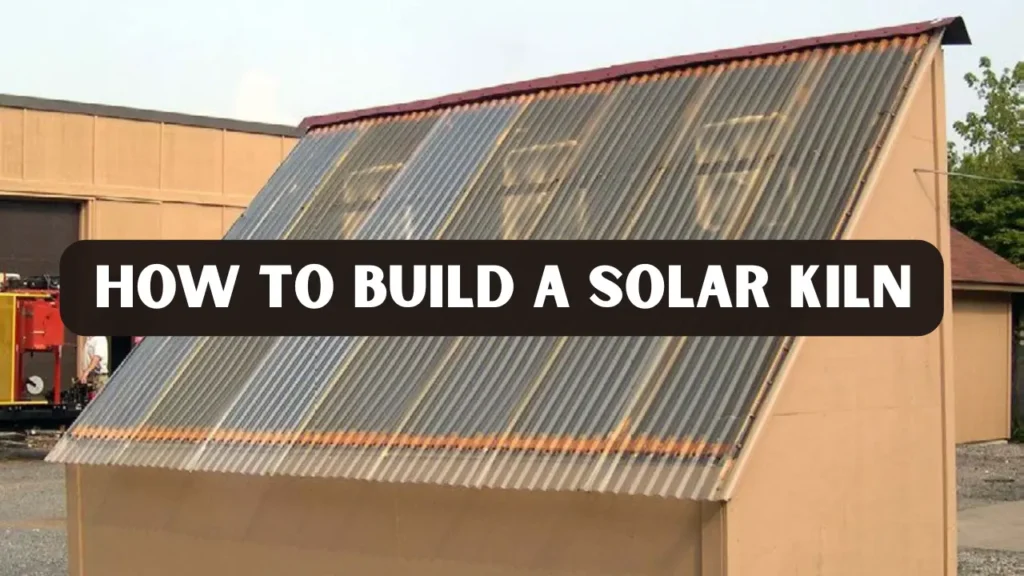Drying lumber properly is essential for successful woodworking projects, and knowing how to build a solar kiln is a key step in achieving this. If wood is not dried correctly, boards can warp, crack, or lose strength before reaching your lathe or workbench. Ensuring proper moisture content helps maintain the durability and stability of your lumber, making it suitable for furniture, carvings, and other woodworking applications.
A solar kiln offers an efficient, eco-friendly, and cost-effective solution for drying wood. By harnessing the power of sunlight, it allows you to dry lumber throughout the year while controlling temperature and humidity. In this guide, you will learn the process from start to finish, understand its working principles, and achieve optimal results when preparing your lumber.
Understanding the Purpose of a Solar Kiln
Before diving into the building process, it’s important to understand why a solar kiln is worth the effort. A solar kiln uses the power of sunlight to heat air and remove moisture from lumber in a controlled environment. Unlike air drying, which can take several months, a solar kiln can dry wood in just a few weeks. This approach gives woodworkers full control over the drying rate, temperature, and humidity, leading to stronger and more stable boards.
Solar kilns are also energy-efficient. They require no electricity beyond small fans and rely almost entirely on renewable solar energy. This makes them ideal for hobbyists and professionals who want to reduce costs and environmental impact while maintaining excellent lumber quality.
Why You Should Build a Solar Kiln
Deciding to build a solar kiln can significantly improve your woodworking projects. When you dry lumber yourself, you control the entire process from cutting logs to preparing the final planks. You can ensure that the wood you use is perfectly dried, free of internal stress, and ready for turning, carving, or furniture building.
Another major benefit is cost. Commercially dried lumber can be expensive, especially for large quantities or unique species. By building your own solar kiln, you reduce the need for external drying services and make the most of locally available timber. The kiln also helps preserve wood that might otherwise degrade during long air-drying periods.
Beyond savings, a solar kiln adds flexibility. You can dry wood on your schedule and choose the moisture level that best suits your specific project. Whether you’re crafting bowls, cabinets, or detailed joinery, properly dried lumber is the foundation of success.
How a Solar Kiln Works
A solar kiln works by trapping sunlight to heat air inside an insulated chamber. The heat evaporates moisture from the wood, while fans circulate the warm air to maintain even conditions throughout the kiln. Vents allow the humid air to escape, keeping the internal humidity at optimal levels for controlled drying. This ensures that the wood dries evenly without developing cracks or warping.
The design typically includes a clear roof or solar collector that absorbs sunlight. Insulated walls prevent heat loss and maintain consistent temperatures inside the chamber. The chamber should be large enough to hold stacked lumber with enough space for airflow. Fans can be added to enhance circulation, creating a controlled environment that protects the quality of the lumber.
This natural drying system works efficiently in most climates when the kiln is oriented south for maximum sunlight exposure. Even during cooler months, the greenhouse effect inside the kiln maintains steady temperatures. Regular monitoring of temperature and humidity ensures uniform drying, preventing case hardening and surface cracks. Consistent conditions allow your lumber to reach optimal moisture content safely and effectively.
Materials and Tools Required
To build a solar kiln, you’ll need a few basic construction materials. Most builders use standard lumber to create the frame, treated plywood for panels, and transparent roofing material such as polycarbonate or tempered glass for the collector surface. Insulation is essential for keeping the heat inside the chamber and maintaining even drying conditions. These materials are widely available and provide the durability needed for a long-lasting kiln.
You’ll also need a few accessories to regulate airflow and monitor the drying process. These include vents, a thermometer, and one or two small fans, which can be powered by solar panels. A moisture meter is useful for checking when your lumber has reached the desired moisture content. The total cost depends on the size and quality of materials, but most small kilns can be built for under $500 using readily available supplies.
Building a solid base and ensuring tight seals around panels are critical to maintaining heat efficiency. A sturdy platform prevents air leaks and guarantees stability during loading and operation. Careful attention to these details ensures that your solar kiln will function efficiently and provide consistent drying results for your lumber.
Step by Step Process
Step 1: Planning the Size and Layout
Start by deciding how much wood you plan to dry at once. The kiln size should be based on your lumber volume and the lengths of your boards. For most small woodworking shops, a chamber that holds 500 to 1000 board feet of lumber is sufficient. Make sure to sketch your design carefully, leaving enough space between the collector section and the chamber for proper air circulation. Consider the orientation and placement of the kiln to maximize sunlight exposure throughout the day.
Step 2: Building the Frame
Construct the base and frame using pressure-treated lumber to ensure durability. The frame should be level and strong enough to support both the structure and the weight of stacked wood. Apply weather-resistant sealants on all joints to prevent heat loss and moisture intrusion. This foundation forms the skeleton of your kiln and determines its long-term performance. Ensure that all corners are square and connections are tight for maximum stability and efficiency.
Step 3: Installing the Solar Collector
The collector is the most important part of your kiln. It captures sunlight and converts it into heat energy. Attach the transparent panels to the roof frame at an angle that matches your location’s latitude, which ensures maximum sunlight exposure throughout the day. Beneath the clear roofing, place a dark-colored metal or plywood surface to absorb and distribute heat evenly inside the kiln. Make sure the collector is securely mounted and sealed to prevent air leaks and maximize efficiency.
Step 4: Insulating and Sealing the Chamber
To maintain consistent temperatures, insulate the kiln walls and floor with rigid foam or fiberglass insulation. Seal all gaps with weatherproof caulk to prevent heat loss. Proper insulation helps retain heat overnight and prevents external air from cooling the chamber. Pay close attention to door seals, as even small leaks can cause uneven drying and energy loss. Additionally, check insulation periodically for wear or gaps to ensure long-term efficiency.
Step 5: Adding Vents and Fans
Airflow is essential for uniform drying. Install intake vents near the bottom of the chamber and exhaust vents at the top to allow warm, moist air to rise and exit naturally while drawing in fresh air from below. Add one or two solar-powered fans to enhance circulation and maintain consistent temperatures throughout the kiln. These fans also help prevent moisture pockets from forming, ensuring even drying of all lumber. Be sure to position vents and fans for optimal airflow throughout the entire chamber.
Step 6: Loading the Lumber
Stack your lumber carefully inside the kiln. Place small spacers, known as stickers, between each board to allow proper air movement. Arrange the stacks so that air can flow freely between all pieces, ensuring even drying throughout. This step is crucial for preventing uneven drying or warping. Make sure not to overload the chamber, as restricted airflow can slow the drying process and affect wood quality.
Step 7: Monitoring the Drying Process
Once the kiln is operational, monitor temperature and humidity regularly. Use a thermometer to track internal conditions and a moisture meter to check the moisture levels of the wood. The goal is to maintain slow, steady drying without overheating, ensuring the wood retains its strength and quality. Depending on the species and thickness, drying may take two to six weeks, with hardwoods generally taking longer than softwoods but yielding more consistent and stable results.
Case Study Efficient Lumber Drying with a Home-Built Solar Kiln
John, a hobbyist woodworker in Oregon, decided to build his own solar kiln to dry his collection of hardwoods. He constructed a kiln with a 700 board-foot capacity using pressure-treated lumber, insulated walls, and a polycarbonate solar collector. By carefully stacking his lumber with stickers and monitoring temperature and humidity daily, John was able to reduce drying time from six months (air-drying) to just five weeks.
During this process, he observed that proper venting and airflow prevented cracking and case hardening, even in thicker oak boards. The kiln maintained consistent temperatures of 110–125 degrees Fahrenheit, with humidity gradually decreasing over the weeks. John’s experience demonstrated that a small, well-designed solar kiln can provide lumber of commercial quality while reducing energy costs and environmental impact.
This case highlights the importance of planning, monitoring, and following best practices when building and operating a solar kiln. Woodworkers of all skill levels can replicate this approach to achieve efficient and reliable results.
Drying Schedule and Best Practices
A solar kiln typically operates between 100°F and 130°F, with humidity gradually decreasing as moisture leaves the wood. Begin with smaller vent openings to retain more heat during the early stages. As the lumber dries, increase vent size to promote faster moisture removal. This balance prevents case hardening, where the wood surface dries too quickly compared to the core.
For optimal results, rotate the stacks midway through the process to ensure uniform drying. Using a digital thermometer and hygrometer allows you to fine-tune airflow and temperature throughout the day. Remember that drying times vary by species; oak, for example, takes longer to dry than pine or cedar. Consistency and patience are key to achieving high-quality lumber.
Maintenance and Troubleshooting
A well-maintained solar kiln can last for many years. Clean the collector panels regularly to remove dust and debris that block sunlight. Check insulation and seals periodically to prevent heat leaks. Inspect fans to ensure they operate efficiently and replace them if airflow decreases. If you notice uneven drying, it could be a sign of insufficient air circulation or improper vent positioning. Adjusting these components usually restores balance quickly.
Mold growth is another potential issue, often caused by excess humidity or poor ventilation. Increasing air movement and venting moisture more frequently resolves this problem. Routine checks help keep your kiln operating efficiently and extend its lifespan.
Safety Tips for Operating a Solar Kiln
Safety should always come first when working with heat and heavy materials. Keep the kiln in an open area with good airflow and away from flammable objects. The collector panels can become very hot, so handle them with gloves if adjustments are needed during operation. Avoid entering the kiln while it’s active, especially during peak sunlight hours.
Ensure that the structure remains stable, particularly if it’s built on uneven ground. Strong winds can affect lightweight designs, so adding anchor supports helps maintain safety. Following these precautions ensures reliable performance and peace of mind.
Cost and Efficiency Overview
The total cost to build a solar kiln depends on materials, size, and location. A small personal kiln might cost between $300 and $500, while larger models for commercial use can exceed $1,000. Despite the upfront expense, the long-term savings are significant. Once built, operating costs are minimal because the system runs almost entirely on solar power. The small amount of electricity needed for fans is often provided by solar panels, making the kiln nearly self-sufficient.
The environmental benefits are equally valuable. Using solar energy reduces carbon emissions compared to traditional fuel-powered kilns. For those interested in sustainability, this method offers a responsible way to prepare lumber while minimizing environmental impact. To learn more about solar energy principles, visit Energy.gov’s Solar Energy Basics.
Conclusion
Learning how to build a solar kiln opens the door to more efficient, sustainable woodworking. By drying your own lumber, you gain control over quality, reduce costs, and support environmentally friendly craftsmanship. With careful planning, proper materials, and attention to detail, you can transform raw, moisture-rich boards into perfectly conditioned lumber ready for any project.
Building a solar kiln is more than just a project, it’s an investment in skill, independence, and sustainability. With patience and precision, your kiln will become one of the most valuable tools in your woodworking workshop.
FAQs
How long does it take to dry wood in a solar kiln?
Drying times vary depending on the type of wood, thickness, and weather conditions. Softwoods can dry within two to four weeks, while dense hardwoods may take up to two months.
What temperature should a solar kiln reach?
Most solar kilns operate best between 100°F and 130°F. Staying within this range ensures steady drying without damaging the wood fibers.
Can I dry different wood types together?
It’s best to group similar wood species with comparable moisture levels. Mixing hardwoods and softwoods can cause uneven drying results.
Do I need electricity to power the kiln?
Not necessarily. Many designs use solar-powered fans and rely entirely on sunlight for heating, making the system fully energy-efficient.
What is the ideal moisture content for finished lumber?
For indoor woodworking projects, wood should reach around 6–8% moisture content. Outdoor materials can be slightly higher, usually around 10–12%.




